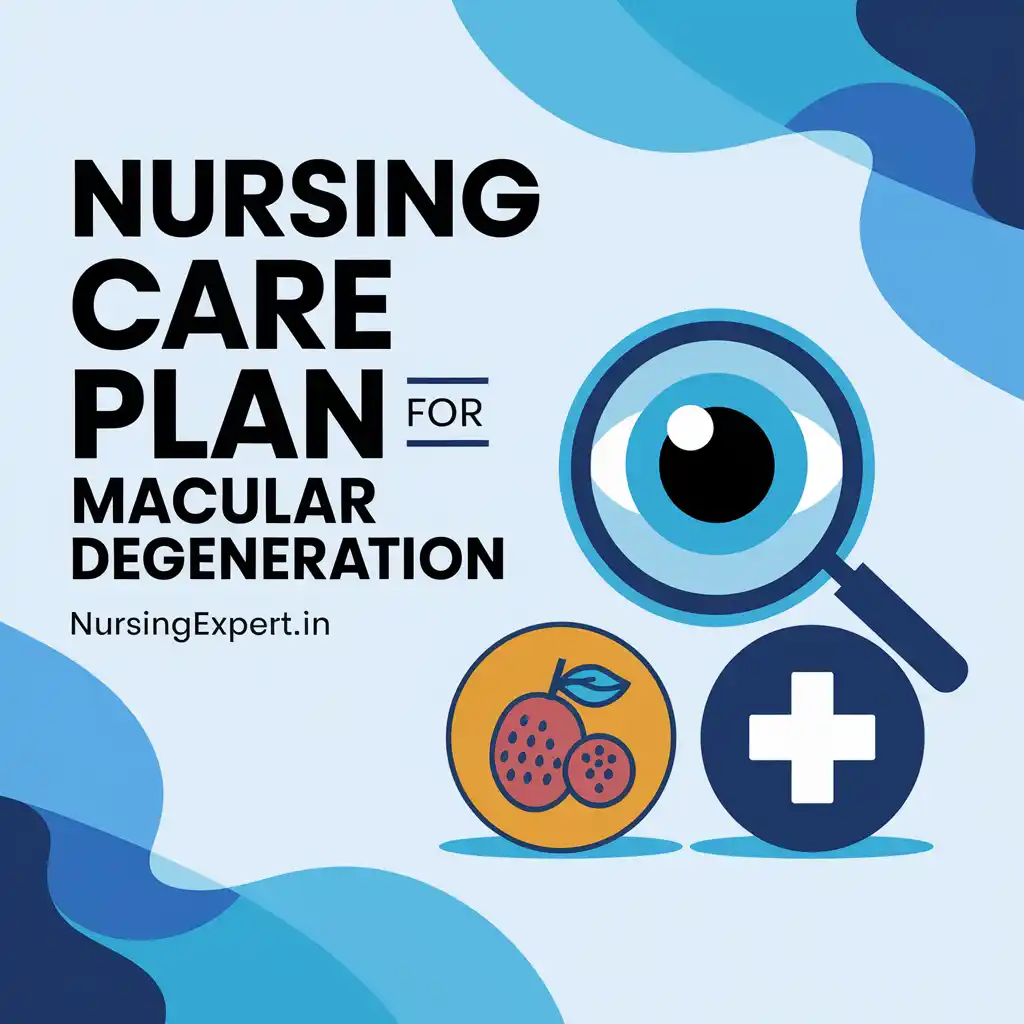Macular degeneration, a leading cause of vision loss in older adults, affects the central part of the retina and can significantly impair daily functioning. A well-organized nursing care plan for macular degeneration provides a structured approach for assessing visual changes, implementing targeted interventions, and educating patients on preserving remaining vision and enhancing quality of life. This guide covers the pathophysiology, etiology, signs and symptoms, nursing diagnoses, and interventions for macular degeneration. A downloadable PDF version of this care plan is available for clinical practice and exam preparation.
Thank you for reading this post, don't forget to subscribe!
1. Introduction
Macular degeneration is a progressive eye condition that primarily affects the macula, the central part of the retina responsible for sharp, detailed vision. It is a major cause of vision impairment among older adults. Nursing care for macular degeneration involves thorough assessment, targeted interventions, and patient education to help slow progression, maximize remaining vision, and improve quality of life. This comprehensive care plan is designed for healthcare professionals and includes a downloadable PDF for easy reference.


2. Understanding Macular Degeneration
Macular degeneration generally presents in two forms: dry (atrophic) and wet (neovascular) macular degeneration. The dry form is more common and progresses slowly, while the wet form can lead to rapid vision loss due to abnormal blood vessel growth. Understanding the specific type and severity of macular degeneration is essential for developing an effective nursing care plan.
3. Pathophysiology
In macular degeneration, the gradual deterioration of the macula leads to central vision loss. Key pathophysiological processes include:
- Dry Macular Degeneration: Characterized by the accumulation of drusen (yellow deposits) and thinning of the retinal pigment epithelium.
- Wet Macular Degeneration: Involves the growth of abnormal blood vessels under the retina, which may leak fluid and blood, leading to rapid damage. These processes disrupt the normal function of the macula, affecting detailed vision and daily activities such as reading and driving.
4. Etiology and Risk Factors
The etiology of macular degeneration is multifactorial. Common risk factors include:
- Age: It predominantly affects individuals over 50.
- Genetic Factors: Family history increases susceptibility.
- Smoking: Significantly elevates the risk of progression.
- Cardiovascular Disease: Associated with compromised blood flow to the retina.
- Diet: Low intake of antioxidants and omega-3 fatty acids may contribute. Identifying these risk factors allows nurses to tailor patient education and preventive strategies effectively.
5. Signs and Symptoms
Patients with macular degeneration may present with:
- Blurry or Distorted Central Vision: Difficulty reading or recognizing faces.
- Dark or Empty Areas in Central Vision: Noticeable gaps in what they see.
- Reduced Color Perception: Colors may appear washed out.
- Difficulty Adapting to Low Light: Challenges in dim environments.
- Gradual Loss of Central Vision: While peripheral vision remains intact. Early identification of these signs supports timely intervention and appropriate management.
6. Nursing Diagnoses
Using NANDA guidelines, common nursing diagnoses for macular degeneration include:
- Impaired Visual Perception related to macular degeneration as evidenced by blurred or distorted central vision.
- Risk for Injury related to decreased visual acuity and impaired depth perception.
- Deficient Knowledge regarding the disease process and preventive strategies.
- Anxiety related to fear of progressive vision loss and loss of independence.
- Ineffective Health Management related to challenges in adapting to vision changes. These diagnoses guide the development of a focused nursing care plan.
7. Nursing Interventions
Key nursing interventions for macular degeneration focus on preserving remaining vision, promoting safety, and enhancing patient education:
- Assess Visual Function:
Regularly evaluate the patient’s visual acuity, contrast sensitivity, and ability to perform daily activities.
Rationale: Ongoing assessment helps monitor disease progression and guides interventions. - Promote Eye Health:
Encourage the use of protective eyewear and proper lighting in the home.
Rationale: Minimizing strain can help preserve existing vision. - Medication Administration:
Administer prescribed treatments, such as anti-VEGF injections for wet macular degeneration, as directed.
Rationale: Medications can slow disease progression and improve outcomes. - Nutritional Support:
Collaborate with dietitians to recommend diets rich in antioxidants, omega-3 fatty acids, and vitamins C, E, and zinc.
Rationale: Proper nutrition may slow the progression of macular degeneration. - Patient Safety Measures:
Educate on home modifications (e.g., clear pathways, good lighting) to prevent falls and injuries.
Rationale: Reducing environmental hazards is essential for patients with impaired central vision. - Facilitate Adaptive Techniques:
Introduce assistive devices such as magnifiers, large-print materials, and voice-activated technology.
Rationale: These tools help patients maintain independence in daily tasks. - Provide Emotional Support:
Offer counseling and support resources to address anxiety and depression related to vision loss.
Rationale: Emotional well-being is crucial for overall quality of life.
8. Patient and Family Education
Effective education is essential in managing macular degeneration:
- Explain the Condition:
Describe the disease, its progression, and its impact on vision in simple, clear terms. - Discuss Treatment Options:
Explain available therapies, including medications and nutritional supplements, and their benefits. - Promote Lifestyle Modifications:
Advise on smoking cessation, a balanced diet, and regular exercise to support overall health. - Teach Safety Measures:
Provide guidance on home modifications to enhance safety and reduce the risk of falls. - Introduce Adaptive Technologies:
Educate on the use of assistive devices that can improve daily functioning. - Encourage Regular Follow-Up:
Stress the importance of routine eye examinations and adherence to treatment schedules. Empowering patients and families through education improves self-management and overall outcomes.
9. Interdisciplinary Collaboration
Managing macular degeneration effectively requires collaboration among healthcare professionals:
- Ophthalmologists:
To diagnose and monitor the progression of macular degeneration and administer treatments. - Optometrists:
For regular eye examinations and vision assessments. - Dietitians:
To provide nutritional guidance that may slow disease progression. - Occupational Therapists:
To assist with adaptive strategies and daily living modifications. - Mental Health Professionals:
To support patients in coping with anxiety and depression related to vision loss. - Patient Educators:
To reinforce self-care techniques and provide additional educational materials. This interdisciplinary approach ensures a comprehensive, patient-centered care plan.
10. Sample Nursing Care Plan for Macular Degeneration
Below is a sample nursing care plan for macular degeneration, outlining key steps:
| Assessment | Nursing Diagnosis | Goal/Expected Outcome | Intervention/Planning | Implementation | Rationale | Evaluation |
|---|---|---|---|---|---|---|
| Subjective Data: – Patient reports blurred central vision and difficulty reading small print. Objective Data: – Visual acuity reduced; difficulty with contrast sensitivity; normal peripheral vision. | Impaired Visual Perception related to macular degeneration as evidenced by blurred central vision and reading difficulties. | Short-Term: – Within 1 week, patient will demonstrate improved use of adaptive strategies for reading. Long-Term: – Patient maintains functional independence with enhanced visual aids and support. | Introduce magnifiers and large-print materials; educate on the importance of proper lighting; schedule regular eye exams. | Provide adaptive devices; instruct patient on their proper use; document improvements in reading ability. | Adaptive devices help compensate for vision loss and improve daily functioning. | Patient reports improved reading ability; increased independence in visual tasks; consistent use of adaptive devices noted. |
| Subjective Data: – Patient expresses anxiety about progressive vision loss and its impact on independence. Objective Data: – Patient appears anxious; verbalizes fear of losing autonomy. | Anxiety related to fear of further vision loss and dependency as evidenced by patient reports and signs of distress. | Short-Term: – Within 24 hours, patient will report decreased anxiety and demonstrate effective coping strategies. Long-Term: – Patient participates in support groups and utilizes relaxation techniques, resulting in improved emotional well-being. | Provide emotional support and counseling; teach relaxation techniques such as deep breathing and mindfulness; offer referrals to support groups. | Conduct individual counseling sessions; distribute relaxation resources; schedule follow-up to assess emotional status. | Reducing anxiety enhances overall quality of life and supports treatment adherence. | Patient reports reduced anxiety; engages in relaxation exercises; positive feedback from support groups. |
| Subjective Data: – Patient is uncertain about necessary lifestyle changes and dietary modifications to support eye health. Objective Data: – Patient asks questions about diet and nutrition; shows lack of awareness regarding risk factors. | Deficient Knowledge regarding macular degeneration management as evidenced by patient uncertainty about diet, exercise, and self-care practices. | Short-Term: – Within 24 hours, patient will verbalize key strategies for managing macular degeneration. Long-Term: – Patient adheres to dietary and lifestyle modifications that support eye health. | Develop a comprehensive education plan on nutrition, exercise, and self-care strategies; provide written and visual materials; review key points in follow-up sessions. | Conduct one-on-one teaching sessions; distribute educational brochures; reinforce learning during subsequent visits. | Patient education is critical for long-term management and prevention of further vision loss. | Patient demonstrates improved understanding; adherence to lifestyle changes confirmed during follow-up; self-reported improvement in vision management. |
11. Downloadable Nursing Care Plan for Macular Degeneration PDF Download
Nursing Care Plan for Macular Degeneration PDF Download
Access our complete nursing care plan for macular degeneration PDF download. This resource provides detailed, step-by-step instructions, nursing diagnoses, targeted interventions, and patient education strategies to manage macular degeneration effectively. Use this document for clinical practice or exam preparation.
📥 Download Nursing Care Plan for Macular Degeneration PDF
12. Frequently Asked Questions (FAQs)
- What is macular degeneration?
Macular degeneration is an eye condition that affects the macula, leading to loss of central vision and difficulties with detailed tasks. - What are common symptoms of macular degeneration?
Symptoms include blurred or distorted central vision, difficulty reading, and decreased ability to recognize faces. - How is macular degeneration managed?
Management includes adaptive devices, medications (especially for wet macular degeneration), lifestyle modifications, and regular ophthalmologic evaluations. - What lifestyle changes can help slow the progression of macular degeneration?
A balanced diet rich in antioxidants, smoking cessation, regular exercise, and proper eye protection are essential. - How do nurses evaluate the success of a macular degeneration care plan?
Success is measured by improved functional vision, patient adherence to adaptive strategies, and enhanced quality of life.
13. Conclusion
A comprehensive nursing care plan for macular degeneration is essential for managing this progressive condition. Through detailed assessments, targeted interventions, and ongoing patient education, nurses can help patients maximize their remaining vision and maintain independence. This guide serves as a valuable resource for clinical practice and exam preparation.
14. References and Sources
- Mayo Clinic. (2023). Age-Related Macular Degeneration (AMD): Overview, Symptoms, and Treatment. Retrieved from https://www.mayoclinic.org/diseases-conditions/age-related-macular-degeneration
- MedlinePlus. (2023). Macular Degeneration. Retrieved from https://medlineplus.gov/maculardegeneration.html
- National Eye Institute. (2023). Facts About Age-Related Macular Degeneration. Retrieved from https://www.nei.nih.gov/learn-about-eye-health/eye-conditions-and-diseases/age-related-macular-degeneration
- American Academy of Ophthalmology. (2023). Managing Age-Related Macular Degeneration. Retrieved from https://www.aao.org
- Centers for Disease Control and Prevention (CDC). (2023). Vision Health: Age-Related Macular Degeneration. Retrieved from https://www.cdc.gov/visionhealth


